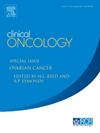宫颈癌近距离治疗中 CT 引导与所有 MRI 引导方案的临床结果比较:单个研究所的经验。
IF 3.2
3区 医学
Q2 ONCOLOGY
引用次数: 0
摘要
目的:图像引导自适应近距离放射治疗(IGABT)是宫颈癌患者的标准治疗方法。本研究旨在比较计算机断层扫描(CT)引导和磁共振成像(MRI)引导方案的治疗效果和不良反应:回顾性研究了2012年至2016年使用外照射放疗后进行IGABT治疗的宫颈癌患者的数据。将CT引导下的IGABT与MRI引导下的IGABT的三种模式进行了比较:近距离放疗前(MRI Pre-BT)不插入敷贴器进行融合、规划MRI并在至少1个分段(MRI ≥1Fx)中插入敷贴器、在每个分段(MRI EveryFx)中进行MRI。采用描述性统计、生存率统计和相关性统计分析了患者特征、肿瘤学结果和后期放射毒性:共对 354 名患者进行了评估,中位随访时间为 60 个月。CT引导、MRI PreBT、MRI ≥1Fx和MRI EveryFx IGABT的5年总生存率(OS)分别为61.5%、65.2%、54.4%和63.7%,无显著差异(P = 0.522)。5年局部控制率(LC)分别为92.1%、87.8%、80.7%和76.5%(p = 0.133),CT引导和MRI ≥1Fx之间差异显著(p = 0.018)。CT引导、MRI ≥1Fx和MRI EveryFx的3-4级晚期胃肠道毒性率为6%,MRI PreBT为8%。CT引导下的3-4级晚期泌尿生殖系统毒性发生率为4%,MRI PreBT为2%,MRI ≥1Fx为1%,MRI EveryFx为0。MRI PreBT、MRI ≥1Fx和MRI EveryFx的肿瘤学和毒性结果无明显差异:结论:与所有磁共振成像方案相比,CT引导下的IGABT可获得可接受的5年OS、LC和毒性,在资源有限的情况下是一种潜在的可行方案。本文章由计算机程序翻译,如有差异,请以英文原文为准。
Clinical Outcome Comparison between CT-Guided Versus all MRI-Guided Scenarios in Brachytherapy for Cervical Cancer: A Single-Institute Experience
Objectives
Image-guided adaptive brachytherapy (IGABT) is the standard of care for patients with cervical cancer. The objective of this study was to compare the treatment outcomes and adverse effects of computed tomography (CT)-guided and magnetic resonance imaging (MRI)-guided scenarios.
Materials and Methods
Data of patients with cervical cancer treated using external beam radiotherapy followed by IGABT from 2012 to 2016 were retrospectively reviewed. CT-guided IGABT was compared with the three modes of MRI-guided IGABT: pre-brachytherapy (MRI Pre-BT) without applicator insertion for fusion, planning MRI with applicator in-place in at least 1 fraction (MRI ≥1Fx), and MRI in every fraction (MRI EveryFx). Patient characteristics, oncologic outcomes, and late radiation toxicity were analyzed using descriptive, survival, and correlation statistics.
Results
Overall, 354 patients were evaluated with a median follow-up of 60 months. The 5-year overall survival (OS) rates were 61.5%, 65.2%, 54.4%, and 63.7% with CT-guided, MRI PreBT, MRI ≥1Fx, and MRI EveryFx IGABT, respectively with no significant differences (p = 0.522). The 5-year local control (LC) rates were 92.1%, 87.8%, 80.7%, and 76.5% (p = 0.133), respectively, with a significant difference observed between the CT-guided and MRI ≥1Fx (p = 0.018). The grade 3–4 late gastrointestinal toxicity rates were 6% in the CT-guided, MRI ≥1Fx, and MRI EveryFx, and 8% in MRI PreBT. The grade 3–4 late genitourinary toxicity rates were 4% in the CT-guided, 2% in MRI PreBT, 1% in MRI ≥1Fx, and none in MRI EveryFx. No significant differences were observed in the oncologic and toxicity outcomes among MRI PreBT, MRI ≥1Fx, and MRI EveryFx.
Conclusions
CT-guided IGABT yielded an acceptable 5-year OS, LC, and toxicity profile compared with all MRI scenarios and is a potentially feasible option in resource-limited settings.
求助全文
通过发布文献求助,成功后即可免费获取论文全文。
去求助
来源期刊

Clinical oncology
医学-肿瘤学
CiteScore
5.20
自引率
8.80%
发文量
332
审稿时长
40 days
期刊介绍:
Clinical Oncology is an International cancer journal covering all aspects of the clinical management of cancer patients, reflecting a multidisciplinary approach to therapy. Papers, editorials and reviews are published on all types of malignant disease embracing, pathology, diagnosis and treatment, including radiotherapy, chemotherapy, surgery, combined modality treatment and palliative care. Research and review papers covering epidemiology, radiobiology, radiation physics, tumour biology, and immunology are also published, together with letters to the editor, case reports and book reviews.
 求助内容:
求助内容: 应助结果提醒方式:
应助结果提醒方式:


